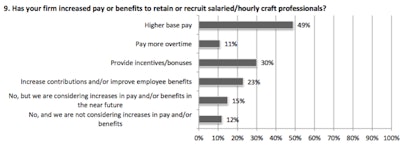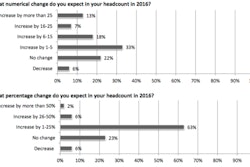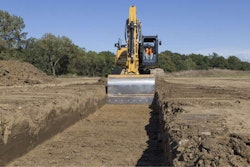
As we reported yesterday, a majority of construction firms in the U.S. are optimistic about 2016 volumes and plan to hire more workers to meet likely increased demand.
But their optimism is significantly tempered by two still-lingering factors: a shortage of available workers to hire and the quality of worker they’re seeing walk through their doors. And that’s despite meaningful changes to compensation.
According to Associated General Contractors of America’s 2016 Construction Outlook Survey, though 71 percent of 1,580 responding U.S. contractors say they plan on hiring more workers this year, 52 percent say the shortage of available workers is their biggest concern.
And 45 percent listed worker quality as theirs.
In fact, 39 percent said they are “have a hard time filling both salaried and craft worker positions,” while 40 percent say they don’t expect that to change any time soon.
This might explain why, despite nearly two-thirds of respondents voicing their plans to hire, nearly as many say they only anticipate their actual headcount to increase between 1 and 25 percent:

In response to these difficulties, 49 percent of responding firms say they have increased base pay to attract better workers. But that’s not all. Twenty-three percent say they have increased contributions and/or have improved employee benefits. Another 15 percent said they are considering such increases.

Beyond boosting pay and benefits, economists have urged contractors to also up their investment in training and development of the construction workforce which is quickly aging out and with little interest from younger Americans in filling in the gaps.
The good news on that front is that 46 percent of respondents to the AGC survey say they do plan on increasing such investments. However, 46 percent also said they plan on keeping theirs the same.
Unfortunately, it looks as though before the industry will see any real change in the size or quality of available workforce, this last figure will need to skew much more in the direction of increased investment in training and development.










